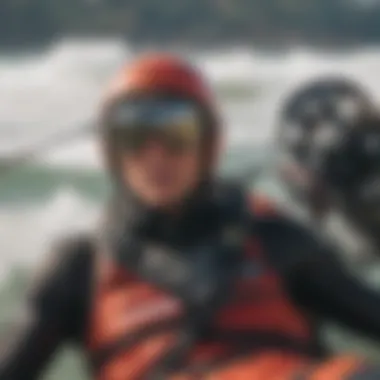Instructor Training Course Online: Enhance Kiteboarding Skills


Intro
In recent years, kiteboarding has emerged as one of the most exhilarating outdoor activities, attracting adventurers and ocean lovers alike. As this sport continues to gain traction, the demand for qualified instructors has surged. Enter online instructor training courses, which allow aspiring teachers to gain knowledge and skills from the comfort of their own homes, making kiteboarding education more accessible than ever.
These courses cater to a broad spectrum of individuals. Whether you are a seasoned kiteboarder looking to formalize your expertise or a newcomer ready to dive deep into this thrilling sport, the insights provided through such training can significantly enhance your teaching capabilities. This article takes a closer look at the essential elements of online courses, the critical skills you can acquire, and the benefits of taking part in structured kiteboarding instruction.
As we journey through essential gear insights and crucial techniques, we’ll lay out a comprehensive roadmap to help you navigate the waters of kiteboarding education. Ready to hit the ground running? Let’s get started.
Prelims to Instructor Training Online
In the fast-paced world of kiteboarding, education has taken a quantum leap forward with the advent of online instructor training courses. This transformation is not simply about convenience; it reshapes how knowledge and skills are imparted to aspiring instructors. The importance of this topic lies in understanding the various dimensions that come into play when individuals decide to elevate their kiteboarding expertise through online platforms.
The crux of kiteboarding education today involves adapting to the dynamics of learning preferences, leveraging innovative technology, and recognizing the demand for well-trained instructors. Online courses offer a flexible, accessible means for learners to hone their skills, developing competence and confidence in a manner that fits their unique schedules. The inclusion of essential curriculum elements—safety protocols, equipment knowledge, and teaching strategies—ensures comprehensive coverage of what it takes to be a successful instructor.
The Evolution of Kiteboarding Education
Kiteboarding education has evolved significantly over the years, reflecting broader trends in sports training and pedagogy. From informal gatherings on the beach, where tips were exchanged among enthusiasts, to professionally structured lessons involving specialized instructors, the shift has been quite profound. With kiteboarding gaining popularity, the need for a more organized and standardized approach to teaching became evident.
Online platforms have played a pivotal role in enabling this evolution. They offer courses that integrate up-to-date techniques, safety standards, and instructional strategies that keep pace with industry advancements. As kiteboarding burgeons as a recognized sport, the evolution isn't merely in the availability of training; it's about improving quality and outcomes for both instructors and learners alike.
The Role of Online Platforms in Skill Development
Online platforms have opened up new avenues for skill development. They provide anywhere, anytime access to training materials, making it easier for new instructors to learn at their own pace. Here's how these platforms stand out in the kiteboarding education landscape:
- Interactive Content: Many online courses include videos, quizzes, and community forums, allowing learners to engage actively rather than passively consuming information. This interaction fosters an environment conducive to deeper understanding.
- Diverse Learning Tools: Online courses often utilize a mix of multimedia materials. This variety caters to different styles of learning—be it visual, auditory, or kinesthetic. Therefore, instructors can tailor their learning experiences effectively.
- Global Community: Online platforms connect individuals from various backgrounds and locations, creating a diverse environment for sharing ideas and experiences. Networking opportunities abound, enriching the learning process.
In sum, these platforms have an increasingly vital role to play in fostering a new generation of skilled kiteboarding instructors. Their adaptability and inclusivity not only facilitate effective learning but also cultivate a seasoned community dedicated to advancing the sport.
Understanding the Curriculum of Online Courses
In the ever-evolving landscape of kiteboarding education, grasping the curriculum of online courses is essential for aspiring instructors. The richness of such a curriculum not only shapes an instructor's knowledge base but also directly impacts the safety and success of their future students. Many might think that kiteboarding is purely about the thrill of gliding over water, but behind those exhilarating moments lies a structured approach that needs to be well understood.
The curriculum provides a blueprint that encapsulates the necessary skills and knowledge required to teach effectively. A solid understanding of this curriculum helps potential instructors recognize what they need to focus on and enables them to tailor their learning journey around their specific interests and abilities. Therefore, delving into the core components and pedagogical approaches of these courses reveals how they empower learners to elevate their kiteboarding instruction.
Core Components of the Training Program
When analyzing the core components of an online kiteboarding instructor training program, several aspects come to the forefront:
- Safety Protocols: One of the most vital components, focusing on risk mitigation and ensuring that instructors are equipped to handle various emergency situations.
- Technical Skills: This includes everything from understanding wind dynamics and kite mechanics to mastering board and kite control techniques. Each element is crucial for smooth operation out on the water.
- Teaching Methodologies: Effective instructors are not just good kiteboarders; they're also exceptional communicators. Classroom strategies that promote engagement, as well as methods for assessing student progress, are critical.
- Equipment Knowledge: Understanding different types of gear, their uses, and maintenance is fundamental to avoid mishaps while giving lessons.
- Environmental Awareness: Instructors must ably teach students about local conditions, assessing risks such as currents or tides that can affect kiteboarding.
By covering each of these areas, online courses present a comprehensive overview that equips future instructors with the knowledge needed to thrive both in instruction and on the water.
Pedagogical Approaches in Kiteboarding Education
The pedagogical strategies employed in kiteboarding education can significantly influence how effectively instructors convey knowledge to their students. Online platforms often blend a variety of teaching styles to cater to diverse learning preferences:
- Active Learning: Engaging students in simulations, discussions, and interactive activities keeps learners invested and aids in cementing their understanding of complex concepts.
- Visual Aids: Utilizing video tutorials and visual demonstrations highlights tricky maneuvers while allowing learners to see practical applications of what they're learning.
- Peer Feedback: Instructors benefit from peer reviews and group discussions, fostering a learning community where best practices can be exchanged and developed.
- Modular Learning: Customizing learning paths based on prior knowledge enables a more personalized education experience.
Benefits of Online Instructor Training
The shift towards digital formats has transformed many educational avenues, and kiteboarding is no exception. Online instructor training brings a myriad of benefits, especially for aspiring instructors and seasoned kiteboarders looking to enhance their skills. These benefits mainly revolve around flexibility, accessibility, and affordability. Understanding these advantages is crucial for individuals considering a career in kiteboarding instruction.
Flexibility and Accessibility for Learners


One of the most compelling aspects of online training is flexibility. Individuals with varying schedules can pursue their instructor training at their own pace, fitting lessons around work or personal commitments. This self-directed learning enables instructors to progress through the material when it’s convenient, allowing for deeper engagement with the content. For example, someone working a traditional nine-to-five job can dedicate evenings or weekends to studying, ensuring they grasp the material without the stress of needing to rush through classes.
Additionally, accessibility plays a vital role in expanding the pool of prospective instructors. Students from remote areas, or those without easy access to physical training centers, can engage in quality education through online courses. Kiteboarding is a global sport, and with online instruction, learners from different regions can access the same high caliber of training regardless of their geographical limitations. Consider this: an individual in a small coastal town may have limited access to experienced instructors. Online programs create a bridge, connecting them with accredited trainers and a wealth of resources they might not otherwise encounter.
"Online learning breaks down barriers, bringing quality kiteboarding education to anyone with an internet connection."
Cost-Effectiveness Compared to Traditional Courses
Cost is often a significant consideration when pursuing certification as a kiteboarding instructor. Traditional in-person courses can be surprisingly expensive, taking into account travel costs and accommodation options, alongside the course fees. Online courses can significantly reduce these expenses. Learners can save money by studying from home, eliminating the necessity for travel and lodging. Furthermore, many online platforms offer price tiers or subscription models, allowing more control over one's investment in education.
This cost-effectiveness doesn’t equate to lower quality, either. Many online programs deliver high-caliber instruction comparable to in-person courses. Students often access extensive libraries of resources—videos, interactive assessments, and real-world case studies—that enhance the learning experience without the inflated cost of conventional formats. Therefore, it’s prudent for aspiring instructors to weigh these cost aspects. If the overall financial commitment can be lessened without compromising the quality of education, it’s a win-win situation for future kiteboarding professionals.
In summary, the advantages of online instructor training are substantial. The flexibility and accessibility of the format allow a wider range of individuals to engage in kiteboarding education, while cost savings make it a practical choice. Individuals should consider these elements when navigating their options, paving the way toward a successful career in kiteboarding instruction.
Essential Skills for Effective Kiteboarding Instructors
When it comes to teaching the exhilarating sport of kiteboarding, the role of the instructor is more critical than meets the eye. It’s not just about riding the waves or flying high; educators need a robust skill set that combines technical prowess with the ability to connect with students. As the kiteboarding landscape shifts toward a more accessible and digital format, instructors equipped with the right skills create safer, more enriching experiences for their students. The following sections break down these essential skills.
Technical Proficiencies in Kiteboarding
Mastering kiteboarding goes beyond personal skill; it’s about being able to convey that expertise. Technical proficiency encompasses a broad range of abilities—including understanding wind patterns, equipment setup, and performing safety checks. Here are several focal points:
- Equipment Knowledge: Instructors must know the ins-and-outs of kites, boards, and harnesses. For instance, while dismissing the importance of the right board might seem trivial to experienced riders, choosing the appropriate size and shape can mean the difference between a successful learning experience and one filled with frustration.
- Safety Protocols: A deep understanding of safety measures is paramount. This means not only knowing how to react in emergencies but also teaching students about potential risks and how to mitigate them. An instructor’s ability to communicate these protocols clearly can instill confidence in learners.
- Experience with Conditions: Knowledge of local kiteboarding conditions—like tides, currents, and weather—is crucial. Instructors should be able to interpret environmental cues to ensure that students are riding in the safest possible conditions.
The joy of kiteboarding is amplified when the instructor can pass on these technical skills effectively, making students not just a part of the sport but confident participants.
Interpersonal Skills and Communication
Technical skills, while critical, will only take an instructor so far. Interpersonal skills and effective communication are the glue that holds the teaching process together. Here’s how:
- Building Rapport: Establishing a comfortable relationship with students is foundational. Instructors need to understand that newbies may feel a bit intimidated by both the sport and the learning environment. Taking the time to connect on a personal level can break down barriers and encourage open communication.
- Adaptability in Teaching Styles: Not every student learns the same way. While some may grasp concepts quickly through verbal instructions, others benefit more from visual or hands-on guidance. A successful instructor can adapt their teaching style to fit each student, enhancing the overall learning experience.
- Effective Feedback and Motivation: Recognizing progress, even small victories, keeps learners motivated. Providing constructive feedback helps students feel supported and engaged, allowing them to push through their limits. An encouraging word at the right time can spark a newfound enthusiasm for mastering a trick or technique.
In sum, the ability to communicate effectively doesn’t just enhance the learning environment; it lays the groundwork for fostering a community of kiteboarders who are eager to share their passion.
"A kiteboarding instructor's greatest asset lies in the blend of technical skills and the ability to connect with students on a personal level."
By honing both technical proficiencies and interpersonal skills, kiteboarding instructors will be better equipped to elevate the learning experience, ultimately shaping the sport’s future for each eager participant.
Certification Processes and Standards
Certification processes and standards play a crucial role in the realm of kiteboarding instruction. They act as gatekeepers, ensuring that individuals who aspire to teach have met certain criteria that reflect both skill and knowledge. These standards not only safeguard the quality of instruction but also enhance the credibility of instructors. This is essential in a sport where both safety and performance are paramount.
Accreditation Organizations in Kiteboarding
Numerous accreditation organizations oversee the training and certification of kiteboarding instructors. These bodies are responsible for creating guidelines and maintaining the integrity of the certification process. Some prominent entities include the International Kiteboarding Organization (IKO) and the American Kiteboarding Association (AKA).
- International Kiteboarding Organization (IKO): IKO provides a robust framework for instructor training, ensuring that its members adhere to industry standards while promoting safety and educational quality. Their rigorous assessment ensures individuals are not just enthusiasts but competent educators.
- American Kiteboarding Association (AKA): Known for advocating safety and growth in kiteboarding, AKA certifies instructors who pass their certifications, which emphasizes advanced skills in wind knowledge, safety procedures, and teaching methodologies.
These organizations often require instructors to undergo a series of workshops and practical evaluations before obtaining certification. The recognition from such professional institutions can significantly uplift an instructor's career, making their certification more respected by schools and students alike.
Recognizing Valid Certifications
In an industry teeming with various training programs, the ability to recognize valid certifications is vital. Not all certifications carry the same weight, making it essential for aspiring instructors and students to discern which credentials are credible.
- Check for Accreditation: Valid certifications usually come from recognized organizations like IKO or AKA. It's important to verify that the program is accredited and meets the necessary standards.
- Know the Curriculum: A reputable certification program has a well-defined curriculum that includes both theoretical and practical aspects of kiteboarding. If a course lacks structured content or focus on safety, it's a red flag.
- Look for Reviews and Testimonials: Feedback from previous participants can be illuminating. Reviews can often provide insight into the training experience and whether it adequately prepared instructors for real-world challenges.
- Consider Continuous Education: Established organizations often require their instructors to participate in ongoing training. Certifications that emphasize professional development are likely more rigorous and credible.


"A good instructor doesn't just know how to ride but understands how to teach with clarity, context, and care."
Enhancing Learning Through Technology
In today’s fast-paced digital landscape, the way individuals learn is being reshaped by technology. In kiteboarding instructor training, leveraging technology is not just a trend; it's a game changer. This section lays out the key aspects of how technology enhances learning and the many advantages it brings to aspiring instructors.
Utilizing Video Analysis for Skill Improvement
Video analysis is becoming a crucial tool in the realm of kiteboarding education. Instructors and students alike find immense value in being able to review the nuances of their performance visually. By recording sessions, learners can watch their own techniques in slow motion, identifying areas for improvement that may not be noticeable in real-time. The benefits are manifold:
- Self-assessment: Instructors can pinpoint weaknesses in their performance, from body positioning to kite control.
- Feedback facilitation: Sharing video clips with peers or experienced mentors can spark constructive feedback, enhancing skill mastery.
- Retention of information: Visual learning aids memory retention, making it easier for students to recall techniques and strategies.
Consider connecting with a network of instructors who use platforms that encourage sharing and analyzing kiteboarding footage. These communities foster growth through critique and observation, turning the solitary sport into a collaborative learning experience.
"When I started using video analysis, I realized how much I overlooked during my rides. It’s like having a coach in my pocket every time I hit the water." - A veteran kiteboarding instructor
Interactive Learning Platforms and Tools
In the era of digital learning, interactive platforms play a vital role in engaging students effectively. These tools not only facilitate traditional learning methods but also offer innovative ways to dive into the sport of kiteboarding. Some of the notable advantages include:
- Engagement: Interactive quizzes, forums, and simulations encourage active participation, making learning feel less like a chore.
- Customization: Aspiring instructors can tailor their learning experiences based on their personal pace and skill level, promoting a more profound understanding of concepts.
- Resource availability: Access to a wealth of online resources, such as instructional videos, articles, and community discussions, fosters continuous learning.
Moreover, platforms that incorporate gamification elements can turn learning into a more enjoyable process. Users are often driven to “level up” their skills much like in a video game, making education feel more dynamic.
In summary, integrating technology in kiteboarding instructor training offers toolsets that enrich the learning experience. It ties together pedagogy and practice, propelling instructors into a realm of possibilities, improving their skills, and preparing them to educate others effectively.
The Growing Demand for Certified Instructors
As kiteboarding continues to soar in popularity across beaches, lakes, and oceans worldwide, the need for qualified instructors is becoming increasingly critical. With a growing number of enthusiasts eager to learn the sport, certified instructors play a vital role in delivering safe and effective training. This demand not only enhances the overall kiteboarding experience for rookies but also supports the integrity of the sport itself.
Market Trends in Kiteboarding Instruction
In recent years, several market trends have been apparent in the realm of kiteboarding instruction. Firstly, the popularity of kiteboarding is swelling, driven by social media influencers showcasing thrilling aerial maneuvers and sun-soaked sessions. As more people are inspired to engage in the sport, local schools and independent instructors are springing up to cater to this newfound interest.
Secondly, there is a noticeable shift towards online training and certifications. The rise of digital platforms allows aspiring instructors to learn at their own pace, making it more convenient for those juggling life’s many responsibilities. Certifying organizations are increasingly offering flexible online courses, which means that potential instructors can access quality education without the hefty price tag or time commitment of traditional face-to-face classes.
Moreover, as competition heats up, kiteboarding schools are raising their standards. Prospective instructors are expected to have not only technical skills but also a substantial understanding of safety practices and teaching methods. This has led to a heightened emphasis on certification programs, which ensure that instructors complete comprehensive training and can deliver a safe learning environment.
The surge in kiteboarding’s popularity is more than just a trend; it’s a fundamental shift in how communities engage with the sport.
Career Opportunities for Certified Instructors
The career landscape for certified kiteboarding instructors is vibrant and diverse. With a valid certification, individuals can explore options that stretch beyond simply teaching. Here are some prominent career paths available:
- Full-time Instructor: Many certified instructors work at kiteboarding schools where they engage students in practical lessons while providing crucial safety education. The ability to work in picturesque locations is often a perk of this role, attracting adventurous souls eager to travel.
- Freelance Instructor: For those with entrepreneurship in mind, establishing oneself as a freelance instructor opens doors to personal branding. With marketing savvy, instructors can offer tailored one-on-one sessions or small group lessons at various beach destinations.
- Tour Guide: A certified instructor can combine their teaching skills with a passion for travel. Many by now have transitioned into guided kiteboarding tours, leading groups through breathtaking spots while educating them along the way.
- Product Ambassador: Equipped with a certification, an instructor can leverage their expertise to partner with brands, acting as a product ambassador by demonstrating gear, providing reviews, or participating in promotional events.
The opportunities are boundless, and as kiteboarding’s popularity flourishes, the demand for qualified instructors will continue to offer these exciting career paths. Investing in certification is not merely a commitment to the sport but a gateway to sustainable careers in a fun, even exhilarating environment.
Safety Protocols in Kiteboarding Training
Safety protocols in kiteboarding training are more than just guidelines; they are the backbone of a secure and effective teaching environment. These protocols ensure that both instructors and students can fully immerse themselves in the sport’s thrill without compromising their safety. In any outdoor sport, the unpredictability of nature adds a layer of complexity, making safety education vital for every practitioner.
Importance of Safety Education
Safety education in kiteboarding brings several key elements to the forefront:


- Risk Awareness: Instructors need to be armed with the ability to identify potential hazards, from changing weather conditions to faulty equipment. By educating themselves and their students about these risks, they create an atmosphere where safety is prioritized.
- Skill Development: Theoretical knowledge of safety doesn’t replace practical skills. Education involves learning how to manage dangerous situations, like quickly detaching the kite from the harness or landing safely during turbulent winds.
- Building Confidence: A comprehensive safety education program helps build confidence in both instructors and students. When kiteboarders know that they have the strategies to handle unexpected scenarios, they can focus on learning and enjoying the sport.
- Regulatory Compliance: Adhering to established safety standards is crucial. Many regions have legal requirements that instructors must fulfill, and being educated in safety protocols can assist in avoiding potential legal pitfalls.
"Safety is not just a practice; it’s a core part of the kiteboarding identity. Embracing safety standards can mean the difference between a good session and a terrible tragedy."
Ultimately, integrating safety education into the training curriculum strengthens the overall experience, ensuring that safety is seen as a shared responsibility among all participants.
Emergency Response Training for Instructors
While preventing accidents is the ideal scenario, having a plan of action in case something goes wrong is just as important. Emergency response training equips instructors with essential skills such as:
- First Aid Skills: This includes knowledge of wound care, CPR, and dealing with common injuries associated with kiteboarding, like joint sprains or abrasions.
- Emergency Communication: Instructors must know how to effectively communicate in high-pressure situations. This may involve calling for help, reporting incidents, or simply conveying clear, calm instructions to students.
- Rescue Techniques: Understanding how to perform rescues is crucial. Instructors should be trained on how to retrieve a stranded kiteboarder, handle panic situations, or assist someone in distress. A mishap in the water can escalate quickly if not managed properly.
- Safety Drills: Regular drills help keep instructors sharp. Practicing simulated emergency scenarios can prepare them to respond quickly and effectively when faced with real-life emergencies, making them more adept at handling crises.
In summary, a robust emergency response training module within the instructor course not only prepares instructors to react competently—but also instills a culture of readiness within the kiteboarding community. Having educators that are prepared for any unforeseen incidents fosters an overall sense of safety, enhancing the kiteboarding environment for everyone involved.
Recommendations for Aspiring Instructors
Becoming a kiteboarding instructor is not just about riding the waves; it involves a deep understanding of the sport, effective teaching strategies, and a commitment to fostering safety and enthusiasm in learners. As aspiring instructors consider this unique career path, various factors come into play, emphasizing the importance of careful preparation and orientation within the kiteboarding community.
Choosing the Right Online Course
Selecting the ideal online course is perhaps the most critical step in an aspiring instructor’s journey. With numerous options available, knowing what to look for can feel like searching for a needle in a haystack. An effective course should align with one’s personal learning style and professional aspirations.
First off, it’s essential to review the course curriculum thoroughly. A quality program should cover both practical and theoretical aspects of kiteboarding instruction, including safety procedures, equipment knowledge, and techniques for teaching students of diverse skill levels. Additionally, consider the reputation of the institution offering the course. Accreditation by recognized organizations ensures that the training received will be valued in the industry.
Another factor to consider is the flexibility of the course schedule. Are sessions pre-recorded or live? Do they allow for interaction with instructors and peers? Effective training isn’t just about the content; it’s also about how it’s delivered. Some courses even integrate video analysis, giving instructors the chance to hone their skills by observing real-life scenarios.
Participants should also look into the support provided post-course. Does the institution offer resources for job placement or additional training? Finding a reliable program can indeed make a world of difference in structuring a successful career.
"The right course is like a roadmap, guiding you to your destination, while helping you avoid the pitfalls along the way." - Anonymous
Building a Network within the Kiteboarding Community
Networking is yet another pillar of success for aspiring instructors. Kiteboarding, like many sports, thrives on community engagement. Particularly for those just starting, establishing connections can open doors to opportunities that might otherwise remain out of reach.
Getting involved in local kiteboarding clubs or online forums can be particularly beneficial. Engaging in these communities allows instructors to share resources, gain insights from seasoned professionals, and even secure potential job leads. Online platforms such as Facebook groups dedicated to kiteboarding can be a fantastic resource. Members often exchange tips, discuss gear and even arrange for coaching sessions or training camps.
Attending kiteboarding events or workshops can also aid in networking. Whether it's a competition or a demo day, these gatherings provide a chance to meet other instructors, enthusiasts, and industry professionals. Establishing a solid network not only improves visibility in the kiteboarding sphere but can also enrich one’s teaching practice through shared experiences and knowledge.
Future Trends in Kiteboarding Instruction
The landscape of kiteboarding instruction is on the brink of transformation. Recognizing the importance of future trends can provide instructors and enthusiasts alike a roadmap to navigate the ever-evolving terrain of this exhilarating sport. Various elements, including educational methodologies and technological advancements, play a pivotal role in shaping the future of kiteboarding education.
Shifts in Educational Methodologies
As the kiteboarding community grows, so does the need for innovative educational approaches. Traditional teaching methods, once sufficient, may not adequately meet the diverse needs of today's learners. The move towards more personalized and adaptive learning experiences is gaining traction. Instructors might adopt blended learning models that combine online coursework with in-person sessions, allowing for a more tailored approach. This means students can take advantage of flexible learning at their own pace.
Moreover, incorporating experiential learning—where learners engage directly with the sport—will become increasingly vital. Such strategies not only engage learners but also enhance retention by linking theory with real-world experience. By leveraging case studies of successful kiteboarders or simulating challenging scenarios, instructors can prepare their students for on-the-water realities.
In addition, peer learning and community engagement are likely to grow in importance. Being part of a supportive learning community can foster networks that boost motivation and encourage collaborative skill development. This trend highlights that education is not just about the individual, but about building connections and sharing experiences within the kiteboarding community.
The Role of Technology in Future Training
Technology is reshaping nearly every aspect of our lives, and kiteboarding education is no exception. The advent of tools like virtual reality (VR) and augmented reality (AR) heralds a new era of immersive training experiences. Imagine a would-be instructor being able to practice techniques in a simulated environment. They could experience various wind conditions, maneuver the equipment, and work through safety protocols without ever stepping foot on the water. Such technology offers a safe space to learn from mistakes, an important element of mastery in any sport.
Additionally, online platforms that facilitate lesson sharing and video critiques are becoming more prevalent. Instructors can upload videos demonstrating their teaching methods and receive feedback from peers or more seasoned professionals. This constructive critique loop can enhance instructional techniques as well as the instructor’s overall effectiveness.
Lastly, data analytics will likely play an increasing role in personalizing the learning journey. Courses that collect performance data can help instructors customize lesson plans based on individual progress. Offering real-time insights could massively improve learning outcomes, ensuring that no instructor or student is left adrift.
"The continually evolving nature of education in kiteboarding reflects a broader trend in many industries: adapt or get left behind."
Embracing these emerging trends is essential not only for those entering the profession but also for seasoned instructors wanting to stay relevant. As the kiteboarding community looks toward the horizon, understanding these shifts will be pivotal in shaping the future of kiteboarding instruction.















